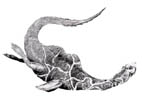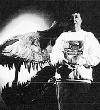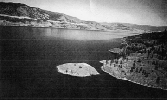 Press Review Press Review
"His mother was an Earwig, his father was a Whale. I'm going to put a little Bit of salt upon his Tail."
By Anne Mayhew
And Ogopogo was his name. Or, ogopogO. The same forwards and backwards. A palindrome on the page, and in the water. Okanagan Lake's legendary monster that no one can make head nor tail of. He usually has a head, though, a head like a goat, or a Doberman pinscher, or a camel; and sometimes he has horns, sometimes ears, occasionally both. He varies from 6 to 15 meters long, and sometimes there's more than one of him.
He was around long before Mr. Bill Brimblecomb borrowed his name in the '20s, long before the 1924 London hit song about a Zulu Chief called Ogopogo. Hundreds of sightings have happened on the lake since Mrs. Susan Allison saw a large creature swimming against the waves of a storm off her Westbank ranch in 1872.
 Things have really heated up in this big, deep British Columbian lake in the past two years. There have been sightings, videos, sonar images, international TV crews, authorities flown in from everywhere, assemblies of biologists, photo negatives off in Japan for study, remotely operated cameras (ROVs), and recently minted monster stamps. Things have really heated up in this big, deep British Columbian lake in the past two years. There have been sightings, videos, sonar images, international TV crews, authorities flown in from everywhere, assemblies of biologists, photo negatives off in Japan for study, remotely operated cameras (ROVs), and recently minted monster stamps.
The lake is agog.
ABC's "Secrets and Mysteries" has visited. Then NBC's "Unsolved Mysteries" which is planning an update. Nippon Television's "World's Supernatural Phenomena" -with 100 million viewers- broadcast a program on Ogopogo last year; returned this year complete with a submarine to scan the lake's bottom. They found only two trout and some transparent shrimp, but aren't discouraged: a sonar image had suggested something large and animate. So it's sayonara, not adieu: they'll be back.
Meanwhile, back at the mother lode, it's been postulated that Scotland's Loch Ness monster is actually a plesiosaur an enormous aquatic reptile supposedly extinct for 65 million years. Therefore, if Nessie is a Plessie, then Ogo could be too. These northern latitude lakes may have more in common than meets the eye.
Kelowna's resident Ogopogo expert Arlene Gaal (author of OGOPOGO: The True Story of the Okanagan Lake Million Dollar Monster) says categorically: "There's no doubt in my mind that Ogopogo is a plesiosaur. Mind you, there are 15 kinds of plesiosaur, and this one would have evolved differently."
And there wouldn't be just one, of course, but a family, Mr. and Mrs., the little ones - a whole flock in fact (or pod, school, pack, tribe, herd, gaggle).
But our story slithers ahead of us.
Let's go back to cryptids. Forget monsters. Mysterious, hidden, unknown animals are no longer called "monsters." The term is undignified, inflammatory. The recently founded BCSCC (British Columbia Scientific Cryptozoology Club) prefers the "more neutral" word, "cryptid."
It comes from the Greek, kruptos, "hidden," through crypt, and cryptic, to cryptozoologists, who study unknown, hidden animals, and cryptids, the animals they study.
This is serious. The International Society of Cryptozoology, founded in Washington, D.C. in 1982, includes on its board of directors biochemist Dr. Roy Mackal, of the University of Chicago, Dr. Eugenie Clark (the shark lady), University of Maryland, and Dr. Paul LeBlond, Head of the Department of Oceanography at the University of British Columbia, who co-founded the B.C. Club.
 The society's purpose is to investigate and analyze "all matters related to animals of unexpected form or size, or unexpected occurrence in time or space." The society realizes there is "much emotional debate" over some creatures reported. Especially the sea serpents, lake monsters, and large hominoids (like the Yeti, the Yowie, and the Sasquatch), but objectivity and scientific method calmly prevail. The society's purpose is to investigate and analyze "all matters related to animals of unexpected form or size, or unexpected occurrence in time or space." The society realizes there is "much emotional debate" over some creatures reported. Especially the sea serpents, lake monsters, and large hominoids (like the Yeti, the Yowie, and the Sasquatch), but objectivity and scientific method calmly prevail.
Precedent for possibility has been established by the amazing number of major animals discovered in recent times. The okapi, a "fossil giraffid" (the society's logo wasn't discovered until 1901; the Komodo dragon turned up in 1912.
Says Dr. Robert Reid, marine biologist and evolutionary theorist at the University of Victoria: "They're turning up living fossils all the time. No one expected the coelacanth." The 2-metre-long fish - closely related to the "fringe-fins" a walking fish of the Devonian period 300 million years ago - was thought to be extinct since the Cretaceous period (6 million years ago), until one was caught by a fisherman on the coast of South Africa in 1938.
Closer to home: "No one believed there was a clam that had no digestive system at all." That was the Solemya reid that Reid discovered in 1979 in Alberni Inlet on Vancouver Island. (Symbiotic bacteria supply all its needs.)
All sorts of surprises are possible, especially in the wide-open spaces of the ocean.
In 1973, Paul LeBlond and John Sibert produced a 6 page document: "Observations of Large Unidentified Marine Animals" in British Columbia and Adjacent Waters. They introduced their report with the words: "To scoffed who insist that there cannot be any more large undiscovered animals nowadays and that reported 'sea-monster' are the result of hallucination, error or bad faith, we can only say that they should not prejudge the case so hastily." document: "Observations of Large Unidentified Marine Animals" in British Columbia and Adjacent Waters. They introduced their report with the words: "To scoffed who insist that there cannot be any more large undiscovered animals nowadays and that reported 'sea-monster' are the result of hallucination, error or bad faith, we can only say that they should not prejudge the case so hastily."
Three years later, off Hawaii, a new, giant shark was discovered with an enormous, luminous mouth and over a hundred rows of teeth. Called Megamouth (Megachasma pelagios), the species was totally unexpected.
So anything can turn up.
The LeBlond/Sibert sea-monster survey documented eyewitness sightings up and down the B.C. coast. Questionnaires went to lighthouse keepers, fishing clubs, marinas, local newspapers. Results helped classify the UMAs (Unidentified Marine Animals) into three main types, two "Merhorses," with horsy heads, long necks, short, dark brown fur, and/or little horns and long, floppy manes; and a long, loopy, serpentine creature with a dorsal fin along the length of its back.
The Merhorses are fast swimmers, and, like Ogopogo, submerge dramatically in a vertical manner, as if suddenly pulled downwards. One has big, dewy eyes; the other is squinty.
What comes of all this is that B.C. appears to be a fertile locale for the unknown. In fact, John Kirk, president of the BCSCC, postulates that B.C. has "more hidden animals per capita than anywhere else on the planet." Scotland has Nessie; Japan has Issie and Kussie (they live in the crater lakes of two volcanoes); and Africa enjoys the MokeleMBembe.
 But here in B.C. we have - besides our King of the Cryptids - a plethora of serpents in 23 other lakes, including Kootenay, Harrison, Osoyoos, and Shuswap; Victoria's Cadborosaurus; and a major Sasquatch or Bigfoot population thought to inhabit the area around Harrison Hot Springs. But here in B.C. we have - besides our King of the Cryptids - a plethora of serpents in 23 other lakes, including Kootenay, Harrison, Osoyoos, and Shuswap; Victoria's Cadborosaurus; and a major Sasquatch or Bigfoot population thought to inhabit the area around Harrison Hot Springs.
As well, Indian legend gives us the slellecum of Cultus Lake, a great bear held responsible for the lake's fierce storms; a sahnis or water grizzly, up the Kitimat River at the Clay Banks; and a monstrous halibut which devoured canoes and caused an awesome tide rip near Alert Bay in northern Vancouver Island.
Further on the fringes of credibility, there was a black alligator reported in Pitt Lake; and then the "Gill Man" who stepped out of Thetis Lake near Victoria some years ago, looking far too much like the Creature from the Black Lagoon to be anything but a hoax.
Most recent was a brand-new monster sighted last year in Victoria's Gorge waterway and immediately nicknamed "Gorgeous." More than sighted, he was discovered swimming along with writer Alison Griffiths, who described him as "almost round, medium grey in color, with purply blotches." Gorgeous indeed. (It was thought later to be either two harbor seals or one large sea lion, attracted by the herring run.) "Gorgeous." More than sighted, he was discovered swimming along with writer Alison Griffiths, who described him as "almost round, medium grey in color, with purply blotches." Gorgeous indeed. (It was thought later to be either two harbor seals or one large sea lion, attracted by the herring run.)
More historically respectable, Cadborosaurus, or "Caddy" to his friends, was first reported back in the 1930s off Victoria beaches. There have been sightings ever since, coming in little peaks or waves of excitement. In the late 60s, the Oregon coast's "Colossal Claude" stole the headlines. With his cameloid head and coarse grey fur, he was identified several times, once feeding on halibut in the Columbia River. Caddy and Claude may be cousins: they may even be one and the same.
Dr. Roy Mackal, who spent a decade as scientific director at Loch Ness, has postulated that Caddy could be a zeuglodon-tooth whale, a supposedly extinct primitive whale. Longer and skinnier than today's whale, this one had small nostrils that neatly poked out of the water, allowing it to breathe without surfacing.
 It's not beyond the realm of possibility that Zeuglodon wandered up the Columbia River and, liking the Okanagan, as everyone does, stayed on. This would make Ogopogo a mammal, however, and there is serious doubt whether a mammal that large would have enough to feed on. It's not beyond the realm of possibility that Zeuglodon wandered up the Columbia River and, liking the Okanagan, as everyone does, stayed on. This would make Ogopogo a mammal, however, and there is serious doubt whether a mammal that large would have enough to feed on.
American cryptozoological researcher Gary Mangiacopra has completed a study on the energy requirements and food supply needed for a breeding colony of lake monsters. He estimates that the Okanagan water system has a total food supply of 65 tonnes of fish, hardly enough to satisfy a family of six-to-ten-metre-long Ogopogi, weighing up to 1,500 kilograms each. Mangiacopra concludes that Ogopogo would have to be a sedentary bottom feeder, an amphibian, or even an invertebrate.
Or could Ogopogo really be a plesiosaur - "a turtle with a snake strung through it" - lingering on in time and space from the Jurassic seas of 65 million years ago?
"Nobody wants it to be new and exciting more than a biologist," says Stan Orchard, research associate in herpetology at the Royal British Columbia Museum. He was called in to view the recent video of "Ogopogo" taken by Vernon resident Ken Chaplin. He saw the video backwards and forwards, saw freeze frames from the video, saw the National Geographic enhanced version. Still, "every key character said it was a beaver." Not a Plessie.
LeBlond isn't comfortable with the idea of a lake monster. He feels there's not likely to be something new in a lake even as big as Okanagan (it's 128 kilometres long, and up to 230 metres deep), because it's contained. Something would have shown by now, and there is simply no evidence: no bones, no droppings, no nests, no nothing. "It's premature to have theories, but I guess people like theories." He feels there's not likely to be something new in a lake even as big as Okanagan (it's 128 kilometres long, and up to 230 metres deep), because it's contained. Something would have shown by now, and there is simply no evidence: no bones, no droppings, no nests, no nothing. "It's premature to have theories, but I guess people like theories."
Nevertheless, people are seeing something in the lake. And it's not just a question of "I'll see it when I believe it." People who don't believe it are seeing it. So what is it?
It's not a sturgeon. Sturgeons don't move the way this thing moves, though they do qualify for the term monster.
The oldest fish in evolutionary terms, they are the largest freshwater fish in North America. An 800-kilogram, 5.5 metre sturgeon was once pulled out of the Fraser River. That's big. But there is no record, only rumor, of sturgeon inhabiting Okanagan Lake.
But there is a Phenomenon. Gerry Frederick, manager of the Kelowna Chamber of Commerce, describes it: "The water is glass-smooth; there is no wind; no trees are moving; there are no boats nearby. Suddenly there is a rolling wake, 25-30 feet long. It moves briskly forward. Suddenly it disappears."
Many people have seen this "disappearing wave." It is not technically a "rogue wave," which is a particularly large wave in a group of smaller waves. The Okanagan Lake Phenomenon involves a glassy smooth surface, and a great deal of sudden turbulence only in the one spot.
LeBlond, an expert on wave dynamics, explains that this breathtaking phenomenon might just be the late appearance of waves generated by a boat. Apparently boat waves move about like echoes, they travel, they can appear long after the boat has moved off. Hello hello.
Shucks.
 Barry Beyerstein is chairman of the B.C. Skeptics Society, the local chapter of CSICOP ("sci cop"), "Committee for the Scientific Investigation of Claims of the Paranormal," founded in Buffalo, New York, about 15 years ago. He, too, would love Ogopogo to exist, but regrets the lack of visible evidence. He is interested in brain mechanisms in perception. We see something strange, inexplicable, and "the mind fills in the fuzzy area, the incomplete percepts." That way we can make sense out of what doesn't make sense. A lone turbulence, snaking forward briskly, develops a head and horns and hoops, all in the mind's eye. Nobody's hoaxing: the brain is just doing its thing. Barry Beyerstein is chairman of the B.C. Skeptics Society, the local chapter of CSICOP ("sci cop"), "Committee for the Scientific Investigation of Claims of the Paranormal," founded in Buffalo, New York, about 15 years ago. He, too, would love Ogopogo to exist, but regrets the lack of visible evidence. He is interested in brain mechanisms in perception. We see something strange, inexplicable, and "the mind fills in the fuzzy area, the incomplete percepts." That way we can make sense out of what doesn't make sense. A lone turbulence, snaking forward briskly, develops a head and horns and hoops, all in the mind's eye. Nobody's hoaxing: the brain is just doing its thing.
Ah shucks.
In the best scientific tradition of skepticism, perhaps it's possible to say that we still don't know. Not everyone is happy about the wave theory. Many respectable, thoughtful people say they've definitely seen an animal. There was something important on that sonar image. Let's leave the doors open to possibility.
Though if there is something animate down there, it may not be quite the cutie that the Chamber of Commerce is nurturing.
The Ogopogo may speak with a forked tongue, its adorable little horned head just the tip of an iceberg that could include legs and claws and a big belly about the size of a three-floor apartment building. "He's never shown any aggressive behavior," says Gerry Frederick, earnestly.
But just wait till June 9, 2000, when that tinned Ogopogo embryo on sale at the Chamber of Commerce for $13.95 is due to be opened. The "little family pet" may have other thoughts.
Remember megamouth.
Meanwhile, Ogopogo can never be disproved, unless the lake runs dry. "It doesn't matter if they ever discover it," says Kelowna Mayor Jim Stuart, a benevolent skeptic who has "Seen the Wave." He says, "There's always that potential that you just might see something."
And there's the hook.
|


